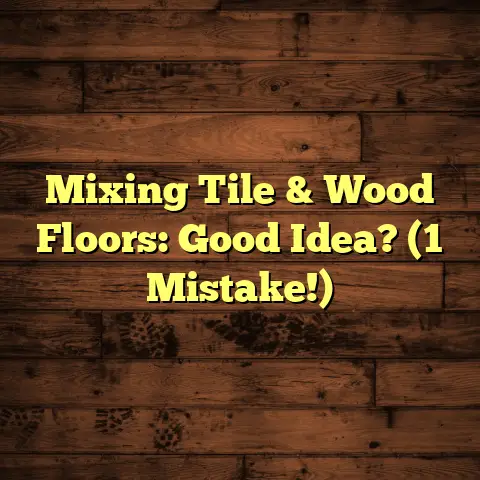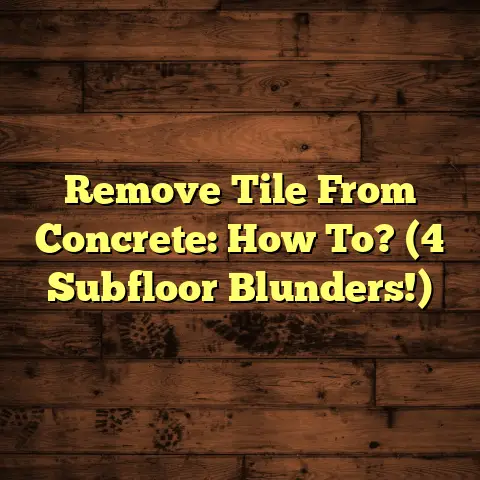How To Transition Between Tile And Wood Floors? (Explained)
I remember stepping into a stunning home filled with natural light, each room telling its own story through the choice of flooring.
The kitchen had this elegant tile work—cool to the touch, glistening under the sunlight—while the living room showcased rich, warm wood floors that invited you to sink your feet into them.
My client was eager to create a cohesive flow between these two beautiful materials, but I knew from experience that this task required more than just a simple installation.
It was about harmonizing the aesthetics and function of both spaces.
As I prepared to tackle this flooring project, I had a myriad of thoughts running through my mind.
How do I ensure a seamless transition that respects both materials?
What techniques will give my client the look they desire without compromising on quality?
Let me take you through my journey, sharing my successes, challenges, and the valuable lessons I’ve learned along the way about transitioning between tile and wood floors.
The Importance of Planning
Before diving into installation, I always emphasize the importance of planning.
This phase is crucial for ensuring that everything goes smoothly later on.
Assessing the Space
The first step I take is assessing the space itself.
Where will the two flooring types meet?
Is there a natural break in the layout, like a doorway or a change in room function?
Understanding these dynamics helps me visualize how to best approach the transition.
In one project, I encountered a situation where the kitchen led directly into a living room with no clear dividing line.
The homeowner wanted the transition to be almost imperceptible.
This called for careful consideration of how the two materials would interact visually and practically.
Choosing the Right Transition Method
When it comes to transitioning between tile and wood floors, several methods can be employed.
Each has its own set of benefits and considerations, which I’ve learned over the years:
- T-Moldings: These are often used in situations where flooring types meet at different heights.
The T-molding allows for some movement between materials while providing a finished look.
I’ve found that high-quality hardwood T-moldings work best as they blend seamlessly with wood floors. - Thresholds: If you want a more defined separation, thresholds can do the trick.
They come in various materials, including wood and metal, and can complement both flooring types beautifully. - Flush Transitions: For a sleek look, flush transitions are an excellent option.
They require precise cutting and alignment but create a unified surface that can be visually stunning when done correctly. - Quarter Round or Shoe Molding: Sometimes, using quarter round or shoe molding can add an attractive finishing touch.
While not always necessary, they can help hide gaps and provide a polished look. - Custom Built Transition Strips: On special occasions, I’ve had clients who requested custom-built transition strips that matched their flooring exactly.
This can be more expensive but offers a unique touch.
Measuring and Cutting
One of the most critical parts of any flooring project is accurate measurement and cutting.
Height Differences
Tile typically measures around 1/4 inch thick, while hardwood can range from 3/4 inch to 5/8 inch thick.
Understanding these specifications helps me plan how to lay out the materials.
If there’s a significant height difference, using a T-molding or threshold often becomes necessary to bridge that gap.
When I first started working in this field, I remember a project where I miscalculated the height difference between tile and wood.
The result was an awkward step-down that didn’t sit well with my client.
Now, I make it a practice to double-check all measurements before proceeding with cutting.
Cutting Techniques
I’ve learned that having the right tools is half the battle.
A quality saw is essential for precise cuts—whether it’s a miter saw for angles or a jigsaw for intricate shapes.
Additionally, when working with tile, I use a wet saw for clean edges.
It minimizes chipping and provides better cuts than traditional saws.
For wood flooring, ensuring my cuts are straight and accurate is vital; any inconsistency can lead to gaps or misalignments during installation.
Installation Process
When it comes to installation, preparation is key. Here’s how I typically approach it:
- Preparing the Subfloor: Before laying down anything, I make sure the subfloor is clean and level.
Any debris or unevenness can affect how well both tile and wood will adhere. - Acclimating Materials: Wood is particularly sensitive to changes in temperature and humidity, so I always recommend letting both wood and tile acclimate in the room for at least 48 hours before installation.
- Laying Tile First: In most cases, I lay down the tile first since it requires adhesive and can be more challenging to adjust once set.
Using spacers helps maintain even gaps for grout lines. - Installing Wood Flooring: Once the tile is secure and dry, I move on to installing the wood flooring.
Depending on the type of wood (nail-down or floating), my approach may differ slightly. - Creating the Transition: After both materials are installed, I focus on creating the transition itself.
Whether I’m using T-moldings or thresholds, ensuring they fit snugly against both surfaces is critical.
Cost Consideration with FloorTally
Cost estimation is vital for any flooring project.
I’ve found that using FloorTally has made this process much easier for me.
By inputting all relevant details—such as area sizes, materials chosen, and local labor rates—I get accurate cost estimates quickly.
For example, when working on transitioning between tile and wood floors, FloorTally allows me to see potential fluctuations in costs based on material choices.
Tile installation can range from $5 to $15 per square foot depending on complexity and type, while hardwood might range from $8 to $12 per square foot.
Having these estimates at hand not only helps me provide transparency to clients but also ensures we stay within budget throughout the project.
Dealing with Challenges
Every project comes with its set of challenges, and this one was no exception.
Uneven Surfaces
During one installation, I discovered that part of the subfloor was uneven—a common issue in older homes.
Instead of panicking, I used leveling compound to create an even surface before proceeding with installation.
This step took extra time but saved me from potential headaches down the road when it came to laying down both tile and wood.
Humidity Issues
Another challenge I faced involved humidity affecting wood expansion after installation.
In one case, I installed wood flooring during summer months when humidity levels were high.
A few weeks later, gaps started appearing between planks due to contraction as temperatures dropped.
Since then, I’ve made it a point to educate clients about moisture control within their homes and recommend using humidifiers or dehumidifiers as needed.
Maintenance Tips
Once my work is done, educating clients on maintenance becomes crucial for longevity.
Here are some tips I share based on years of experience:
- Regular Cleaning: It’s essential to sweep or vacuum regularly to prevent dirt buildup which can scratch surfaces over time.
- Use Appropriate Cleaners: Both tile and wood require different cleaning solutions; using harsh chemicals can damage finishes.
- Moisture Control: Especially in areas where tile meets wood, keeping an eye on moisture levels is key to preventing issues like warping or mold growth.
- Inspect Regularly: Encourage clients to check for gaps or shifting in both materials periodically so they can address any issues early on.
Personal Anecdotes
Throughout my career as a flooring contractor, I’ve encountered many memorable projects—each teaching me something new about transitioning between different floor types.
One particular job involved a beautiful lake house where my client wanted seamless transitions between their indoor living space and outdoor deck area featuring tile and wood respectively.
The challenge was ensuring water drainage wouldn’t affect the transition over time.
We opted for a slightly elevated threshold that allowed water to flow away while still maintaining an aesthetically pleasing connection between spaces.
The end result was stunning—a perfect blend of indoor comfort and outdoor beauty!
Further Considerations
When contemplating flooring transitions, here are some additional factors worth considering:
- Style Choices: The visual appeal matters just as much as functionality.
Discussing style preferences with clients helps guide material choices that will enhance their home’s overall look. - Future Renovations: Always think ahead!
Clients may want different layouts or extensions down the line; understanding their long-term goals can impact your recommendations today. - Local Climate Conditions: Depending on where you live—humid climates vs dry regions—certain materials may perform better than others over time.
Conclusion
Creating a beautiful flow between tile and wood floors requires careful planning, precise execution, and ongoing maintenance considerations.
Each project presents unique challenges but also rewarding outcomes that beautify homes while showcasing craftsmanship.
As I continue navigating these flooring projects throughout my career, every experience enhances my knowledge base—and I look forward to sharing these insights with others in our field!
Whether you’re just starting out or looking for ways to refine your approach—embracing both technical detail and creativity will elevate your work to new heights!
Remember, whether you opt for T-moldings or flush transitions—or any method in between—understanding what works best for your specific situation will make all the difference in achieving stunning results that will last for years to come!
Happy flooring!





